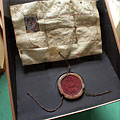(Optimalizované pre zariadenia s malou obrazovkou)
Ráday Mansion and museum - Pécel, Maďarsko
Po kliknutí:
Kliknutím na obrázky!
-

Ráday Mansion
The building is quite similar to the Grassalkovich Palace of Gödöllő also because it was designed by the same architect: Andreas Mayerhoffer.
Dátum fotenie: 19.10.20132013
Vytvoril: Robert Németh
Model fotoaparátu: Konica Minolta Dimage A200
Pécel, Maďarsko
-
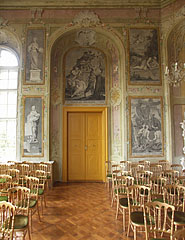
The upstairs Ceremonial Hall, with unique black and white pictures on the wall from the Greek mythology, imitating copperplate engravings
Dátum fotenie: 19.10.20132013
Vytvoril: Robert Németh
Model fotoaparátu: Konica Minolta Dimage A200
Pécel, Maďarsko
-
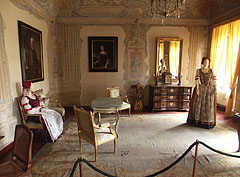
The "King's Saloon" or "Billiard Saloon", furnished as an authentic ladies salon
Dátum fotenie: 19.10.20132013
Vytvoril: Robert Németh
Model fotoaparátu: Konica Minolta Dimage A200
Pécel, Maďarsko
-

The Tardos red marble pillars and the gorgeous frescoes on the ceiling in the Main Library Hall
Dátum fotenie: 19.10.20132013
Vytvoril: Robert Németh
Model fotoaparátu: Konica Minolta Dimage A200
Pécel, Maďarsko
-
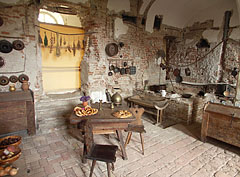
Baroque Kitchen with authentic furnishing
Dátum fotenie: 19.10.20132013
Vytvoril: Robert Németh
Model fotoaparátu: Konica Minolta Dimage A200
Pécel, Maďarsko
-

The baroque Ráday Mansion
It was built in two phases between 1722 and 1770, architects: András Mayerhoffer and his son János, from Salzburg.
Dátum fotenie: 19.10.20132013
Vytvoril: Robert Németh
Model fotoaparátu: Konica Minolta Dimage A200
Pécel, Maďarsko
-

Relief with floral ornamentation on the top of the front wall of the Ráday Mansion
Dátum fotenie: 19.10.20132013
Vytvoril: Robert Németh
Model fotoaparátu: Konica Minolta Dimage A200
Pécel, Maďarsko
-
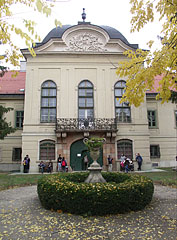
The Ráday Mansion of Pécel (also known as Ráday Palace, Ráday Castle and Kelecsényi Mansion)
Dátum fotenie: 19.10.20132013
Vytvoril: Robert Németh
Model fotoaparátu: Konica Minolta Dimage A200
Pécel, Maďarsko
-
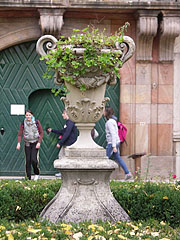
Stone vase in front of the mansion
Dátum fotenie: 19.10.20132013
Vytvoril: Robert Németh
Model fotoaparátu: Konica Minolta Dimage A200
Pécel, Maďarsko
-

Old stove in the Main Library Hall
The statue on its top is a subject of debates: it represents either Voltaire or Moses.
Dátum fotenie: 19.10.20132013
Vytvoril: Robert Németh
Model fotoaparátu: Konica Minolta Dimage A200
Pécel, Maďarsko
-
Pallas Athena on a ceiling fresco of the Main Library Hall
Dátum fotenie: 19.10.20132013
Vytvoril: Robert Németh
Model fotoaparátu: Konica Minolta Dimage A200
Pécel, Maďarsko
Pallas Athena on a ceiling fresco of the Main Library Hall - Pécel, Maďarsko -
Carved wooden chest in the Main Library Hall
Dátum fotenie: 19.10.20132013
Vytvoril: Robert Németh
Model fotoaparátu: Konica Minolta Dimage A200
Pécel, Maďarsko
Carved wooden chest in the Main Library Hall - Pécel, Maďarsko -
The Main Library Hall (or Great Library Hall)
Dátum fotenie: 19.10.20132013
Vytvoril: Robert Németh
Model fotoaparátu: Konica Minolta Dimage A200
Pécel, Maďarsko
The Main Library Hall (or Great Library Hall) - Pécel, Maďarsko -
Main Library Hall (or Great Library Hall)
Dátum fotenie: 19.10.20132013
Vytvoril: Robert Németh
Model fotoaparátu: Konica Minolta Dimage A200
Pécel, Maďarsko
Main Library Hall (or Great Library Hall) - Pécel, Maďarsko -
Wall painting on the ceiling of the Main Library Hall
Dátum fotenie: 19.10.20132013
Vytvoril: Robert Németh
Model fotoaparátu: Konica Minolta Dimage A200
Pécel, Maďarsko
Wall painting on the ceiling of the Main Library Hall - Pécel, Maďarsko -
Shelves full of books in a cabinet of the Small Library Room
Dátum fotenie: 19.10.20132013
Vytvoril: Robert Németh
Model fotoaparátu: Konica Minolta Dimage A200
Pécel, Maďarsko
Shelves full of books in a cabinet of the Small Library Room - Pécel, Maďarsko -
Old books, among others all works of Count Gedeon Ráday in a glass display cabinet of the Main Library Hall
Dátum fotenie: 19.10.20132013
Vytvoril: Robert Németh
Model fotoaparátu: Konica Minolta Dimage A200
Pécel, Maďarsko
Old books, among others all works of Count Gedeon Ráday in a glass display cabinet of the Main Library Hall - Pécel, Maďarsko -
A cabinet in the Small Library Room
Dátum fotenie: 19.10.20132013
Vytvoril: Robert Németh
Model fotoaparátu: Konica Minolta Dimage A200
Pécel, Maďarsko
A cabinet in the Small Library Room - Pécel, Maďarsko -
Carved-painted wooden chest in the Smaller Library Room
Dátum fotenie: 19.10.20132013
Vytvoril: Robert Németh
Model fotoaparátu: Konica Minolta Dimage A200
Pécel, Maďarsko
Carved-painted wooden chest in the Smaller Library Room - Pécel, Maďarsko -
Old carved wooden chest in the Small Library Room
Dátum fotenie: 19.10.20132013
Vytvoril: Robert Németh
Model fotoaparátu: Konica Minolta Dimage A200
Pécel, Maďarsko
Old carved wooden chest in the Small Library Room - Pécel, Maďarsko -
Authentic reading corner in the Small Library Room (which is connected with the greater Main Library Hall)
Dátum fotenie: 19.10.20132013
Vytvoril: Robert Németh
Model fotoaparátu: Konica Minolta Dimage A200
Pécel, Maďarsko
Authentic reading corner in the Small Library Room (which is connected with the greater Main Library Hall) - Pécel, Maďarsko -
Stairs up to the first floor
Dátum fotenie: 19.10.20132013
Vytvoril: Robert Németh
Model fotoaparátu: Konica Minolta Dimage A200
Pécel, Maďarsko
Stairs up to the first floor - Pécel, Maďarsko -
Ceremonial Hall (or Main Hall, sometimes called "Dining Palace") on the first floor
Dátum fotenie: 19.10.20132013
Vytvoril: Robert Németh
Model fotoaparátu: Konica Minolta Dimage A200
Pécel, Maďarsko
Ceremonial Hall (or Main Hall, sometimes called "Dining Palace") on the first floor - Pécel, Maďarsko -
The Ceremonial Hall upstairs, its wall paintings were inspired by copperplate engravings in old books
Dátum fotenie: 19.10.20132013
Vytvoril: Robert Németh
Model fotoaparátu: Konica Minolta Dimage A200
Pécel, Maďarsko
The Ceremonial Hall upstairs, its wall paintings were inspired by copperplate engravings in old books - Pécel, Maďarsko -
A draped piano in front of the wall paintings of the Ceremonial Hall (the pictures were created in 1766)
Dátum fotenie: 19.10.20132013
Vytvoril: Robert Németh
Model fotoaparátu: Konica Minolta Dimage A200
Pécel, Maďarsko
A draped piano in front of the wall paintings of the Ceremonial Hall (the pictures were created in 1766) - Pécel, Maďarsko -
A beautiful white ceramic stove in the Ceremonial Hall (also known as "dining Palace")
Dátum fotenie: 19.10.20132013
Vytvoril: Robert Németh
Model fotoaparátu: Konica Minolta Dimage A200
Pécel, Maďarsko
A beautiful white ceramic stove in the Ceremonial Hall (also known as "dining Palace") - Pécel, Maďarsko -
Glass chandelier in the Ceremonial Hall
Dátum fotenie: 19.10.20132013
Vytvoril: Robert Németh
Model fotoaparátu: Konica Minolta Dimage A200
Pécel, Maďarsko
Glass chandelier in the Ceremonial Hall - Pécel, Maďarsko -
Monochromatic wall painting in the Ceremonial Hall
Inspired by the Deucalion flood myth, when Zeus wants to destroy the mankind.
Dátum fotenie: 19.10.20132013
Vytvoril: Robert Németh
Model fotoaparátu: Konica Minolta Dimage A200
Pécel, Maďarsko
Monochromatic wall painting in the Ceremonial Hall - Pécel, Maďarsko -
A black and white (monochrome) fresco in the Ceremonial Hall
Dátum fotenie: 19.10.20132013
Vytvoril: Robert Németh
Model fotoaparátu: Konica Minolta Dimage A200
Pécel, Maďarsko
A black and white (monochrome) fresco in the Ceremonial Hall - Pécel, Maďarsko -
The entirely preserved original door of the "King's Saloon"
Dátum fotenie: 19.10.20132013
Vytvoril: Robert Németh
Model fotoaparátu: Konica Minolta Dimage A200
Pécel, Maďarsko
The entirely preserved original door of the "King's Saloon" - Pécel, Maďarsko -
Inlaid cupboard (cabinet with marquetry) from 1711, in the "King's Bedroom" (also known as the "room with pictures of the court")
Dátum fotenie: 19.10.20132013
Vytvoril: Robert Németh
Model fotoaparátu: Konica Minolta Dimage A200
Pécel, Maďarsko
Inlaid cupboard (cabinet with marquetry) from 1711, in the "King's Bedroom" (also known as the "room with pictures of the court") - Pécel, Maďarsko -
An escritoire (secretary desk or writing desk) in the "King's Saloon"
Dátum fotenie: 19.10.20132013
Vytvoril: Robert Németh
Model fotoaparátu: Konica Minolta Dimage A200
Pécel, Maďarsko
An escritoire (secretary desk or writing desk) in the "King's Saloon" - Pécel, Maďarsko -
Emerging mural (wall painting) sketches on ceiling of the the former billiard room (now called the "King's Saloon")
Dátum fotenie: 19.10.20132013
Vytvoril: Robert Németh
Model fotoaparátu: Konica Minolta Dimage A200
Pécel, Maďarsko
Emerging mural (wall painting) sketches on ceiling of the the former billiard room (now called the "King's Saloon") - Pécel, Maďarsko -
Predrawings of a fresco (namely the "Judgement of Paris") on the ceiling of the former billiard room (today "King's Saloon")
Dátum fotenie: 19.10.20132013
Vytvoril: Robert Németh
Model fotoaparátu: Konica Minolta Dimage A200
Pécel, Maďarsko
Predrawings of a fresco (namely the "Judgement of Paris") on the ceiling of the former billiard room (today "King's Saloon") - Pécel, Maďarsko -
The former billiard room or "King's Saloon" is decorated as a ladies saloon
Dátum fotenie: 19.10.20132013
Vytvoril: Robert Németh
Model fotoaparátu: Konica Minolta Dimage A200
Pécel, Maďarsko
The former billiard room or "King's Saloon" is decorated as a ladies saloon - Pécel, Maďarsko -
A card table in the former billiard saloon (currently called the "King's Saloon")
Dátum fotenie: 19.10.20132013
Vytvoril: Robert Németh
Model fotoaparátu: Konica Minolta Dimage A200
Pécel, Maďarsko
A card table in the former billiard saloon (currently called the "King's Saloon") - Pécel, Maďarsko -
A lady (actually a mannequin doll) in authentic clothes in the "King's Saloon"
Dátum fotenie: 19.10.20132013
Vytvoril: Robert Németh
Model fotoaparátu: Konica Minolta Dimage A200
Pécel, Maďarsko
A lady (actually a mannequin doll) in authentic clothes in the "King's Saloon" - Pécel, Maďarsko -
The "King's Saloon" or "Billiard Saloon"
Dátum fotenie: 19.10.20132013
Vytvoril: Robert Németh
Model fotoaparátu: Konica Minolta Dimage A200
Pécel, Maďarsko
The "King's Saloon" or "Billiard Saloon" - Pécel, Maďarsko -
After the period when the mansion was MÁV Hospital only this door remained intact, the one between the "King's Saloon" and the "King's Bedroom"
Dátum fotenie: 19.10.20132013
Vytvoril: Robert Németh
Model fotoaparátu: Konica Minolta Dimage A200
Pécel, Maďarsko
After the period when the mansion was MÁV Hospital only this door remained intact, the one between the "King's Saloon" and the "King's Bedroom" - Pécel, Maďarsko -
Beautiful old cabinet in the "King's Bedroom"
Dátum fotenie: 19.10.20132013
Vytvoril: Robert Németh
Model fotoaparátu: Konica Minolta Dimage A200
Pécel, Maďarsko
Beautiful old cabinet in the "King's Bedroom" - Pécel, Maďarsko -
Wall paintings in the "King's Bedroom"
Dátum fotenie: 19.10.20132013
Vytvoril: Robert Németh
Model fotoaparátu: Konica Minolta Dimage A200
Pécel, Maďarsko
Wall paintings in the "King's Bedroom" - Pécel, Maďarsko -
The "King's Bedroom" (also known as the "room with pictures of the court")
Dátum fotenie: 19.10.20132013
Vytvoril: Robert Németh
Model fotoaparátu: Konica Minolta Dimage A200
Pécel, Maďarsko
The "King's Bedroom" (also known as the "room with pictures of the court") - Pécel, Maďarsko -
Authentic copies of old coins in the "King's Bedroom"
And there are some coin paintings on the wall as well.
Dátum fotenie: 19.10.20132013
Vytvoril: Robert Németh
Model fotoaparátu: Konica Minolta Dimage A200
Pécel, Maďarsko
Authentic copies of old coins in the "King's Bedroom" - Pécel, Maďarsko -
Ceiling painting of the goddess of victory in the "King's Bedroom", and pictures of Habsburg monarchs on the walls
Dátum fotenie: 19.10.20132013
Vytvoril: Robert Németh
Model fotoaparátu: Konica Minolta Dimage A200
Pécel, Maďarsko
Ceiling painting of the goddess of victory in the "King's Bedroom", and pictures of Habsburg monarchs on the walls - Pécel, Maďarsko -
Mythological theme monochromatic murals (wall paintings) in the Ceremonial Hall (based on illustrations in old books, among others in Ovid's Metamorphoses)
Dátum fotenie: 19.10.20132013
Vytvoril: Robert Németh
Model fotoaparátu: Konica Minolta Dimage A200
Pécel, Maďarsko
Mythological theme monochromatic murals (wall paintings) in the Ceremonial Hall (based on illustrations in old books, among others in Ovid's Metamorphoses) - Pécel, Maďarsko -
One of the black and white wall paintings, overt the door
Phaeton begs his father Helios (the god of the Sun) to let him drive the sun chariot.
Dátum fotenie: 19.10.20132013
Vytvoril: Robert Németh
Model fotoaparátu: Konica Minolta Dimage A200
Pécel, Maďarsko
One of the black and white wall paintings, overt the door - Pécel, Maďarsko -
A nice white stove in the "queen's bedroom"
Dátum fotenie: 19.10.20132013
Vytvoril: Robert Németh
Model fotoaparátu: Konica Minolta Dimage A200
Pécel, Maďarsko
A nice white stove in the "queen's bedroom" - Pécel, Maďarsko -
Furniture in the "queen's bedroom"
Dátum fotenie: 19.10.20132013
Vytvoril: Robert Németh
Model fotoaparátu: Konica Minolta Dimage A200
Pécel, Maďarsko
Furniture in the "queen's bedroom" - Pécel, Maďarsko -
A cabinet and a stove in the "Queen's Saloon"
Dátum fotenie: 19.10.20132013
Vytvoril: Robert Németh
Model fotoaparátu: Konica Minolta Dimage A200
Pécel, Maďarsko
A cabinet and a stove in the "Queen's Saloon" - Pécel, Maďarsko -
A mirror in the so-called "Queen's Saloon"
Dátum fotenie: 19.10.20132013
Vytvoril: Robert Németh
Model fotoaparátu: Konica Minolta Dimage A200
Pécel, Maďarsko
A mirror in the so-called "Queen's Saloon" - Pécel, Maďarsko -
Hallway on the first floor, with fireplaces and chairs
Dátum fotenie: 19.10.20132013
Vytvoril: Robert Németh
Model fotoaparátu: Konica Minolta Dimage A200
Pécel, Maďarsko
Hallway on the first floor, with fireplaces and chairs - Pécel, Maďarsko -
A "3D" picture in the "Guestroom": "The first encounter of Ferenc Kazinczy and Károly Kisfaludy"
It was created based on the painting of Some Orlai Petrich from 1859.
Dátum fotenie: 19.10.20132013
Vytvoril: Robert Németh
Model fotoaparátu: Konica Minolta Dimage A200
Pécel, Maďarsko
A "3D" picture in the "Guestroom": "The first encounter of Ferenc Kazinczy and Károly Kisfaludy" - Pécel, Maďarsko -
Ferenc Kazinczy memorial corner in the "Guestroom" (Would this be the "Hercules Room"?)
Dátum fotenie: 19.10.20132013
Vytvoril: Robert Németh
Model fotoaparátu: Konica Minolta Dimage A200
Pécel, Maďarsko
Ferenc Kazinczy memorial corner in the "Guestroom" (Would this be the "Hercules Room"?) - Pécel, Maďarsko -
Chains of bondage of Sándor Rózsa legendary and notorious Hungarian outlaw ("betyár")
Gedeon Ráday was a Royal Commissioner and he had this criminal person arrested in 1869.
Dátum fotenie: 19.10.20132013
Vytvoril: Robert Németh
Model fotoaparátu: Konica Minolta Dimage A200
Pécel, Maďarsko
Chains of bondage of Sándor Rózsa legendary and notorious Hungarian outlaw ("betyár") - Pécel, Maďarsko -
A room undergoing renovation
All murals were painted over when a hospital was operated here, the recovery is in progress.
Dátum fotenie: 19.10.20132013
Vytvoril: Robert Németh
Model fotoaparátu: Konica Minolta Dimage A200
Pécel, Maďarsko
A room undergoing renovation - Pécel, Maďarsko -
A diploma with a great seal
Dátum fotenie: 19.10.20132013
Vytvoril: Robert Németh
Model fotoaparátu: Konica Minolta Dimage A200
Pécel, Maďarsko
A diploma with a great seal - Pécel, Maďarsko -
Sooty fireplace in the upstairs corridor
Dátum fotenie: 19.10.20132013
Vytvoril: Robert Németh
Model fotoaparátu: Konica Minolta Dimage A200
Pécel, Maďarsko
Sooty fireplace in the upstairs corridor - Pécel, Maďarsko -
Fireplace in the corridor upstairs
Dátum fotenie: 19.10.20132013
Vytvoril: Robert Németh
Model fotoaparátu: Konica Minolta Dimage A200
Pécel, Maďarsko
Fireplace in the corridor upstairs - Pécel, Maďarsko -
Stairway
Dátum fotenie: 19.10.20132013
Vytvoril: Robert Németh
Model fotoaparátu: Konica Minolta Dimage A200
Pécel, Maďarsko
Stairway - Pécel, Maďarsko -
The brick-floored Baroque Kitchen
Dátum fotenie: 19.10.20132013
Vytvoril: Robert Németh
Model fotoaparátu: Konica Minolta Dimage A200
Pécel, Maďarsko
The brick-floored Baroque Kitchen - Pécel, Maďarsko -
Authentically furnished and decorated Baroque Kitchen
Formerly the staff carried out the completed dish through the doorway that is ahead.
Dátum fotenie: 19.10.20132013
Vytvoril: Robert Németh
Model fotoaparátu: Konica Minolta Dimage A200
Pécel, Maďarsko
Authentically furnished and decorated Baroque Kitchen - Pécel, Maďarsko -
Baroque Kitchen
Dátum fotenie: 19.10.20132013
Vytvoril: Robert Németh
Model fotoaparátu: Konica Minolta Dimage A200
Pécel, Maďarsko
Baroque Kitchen - Pécel, Maďarsko -
A "szuszék" chest in the Baroque Kitchen
This is a benchwood timbered box with a lid, one of the oldest furniture types in the Carpathian Basin.
Dátum fotenie: 19.10.20132013
Vytvoril: Robert Németh
Model fotoaparátu: Konica Minolta Dimage A200
Pécel, Maďarsko
A "szuszék" chest in the Baroque Kitchen - Pécel, Maďarsko -
Coffee roasters on the wall of the Baroque Kitchen
Dátum fotenie: 19.10.20132013
Vytvoril: Robert Németh
Model fotoaparátu: Konica Minolta Dimage A200
Pécel, Maďarsko
Coffee roasters on the wall of the Baroque Kitchen - Pécel, Maďarsko -
Small wood-carved chairs, a table and a copper kettle pot in the Baroque Kitchen
Dátum fotenie: 19.10.20132013
Vytvoril: Robert Németh
Model fotoaparátu: Konica Minolta Dimage A200
Pécel, Maďarsko
Small wood-carved chairs, a table and a copper kettle pot in the Baroque Kitchen - Pécel, Maďarsko -
Kitchen tools on the wall of the Baroque Kitchen
Dátum fotenie: 19.10.20132013
Vytvoril: Robert Németh
Model fotoaparátu: Konica Minolta Dimage A200
Pécel, Maďarsko
Kitchen tools on the wall of the Baroque Kitchen - Pécel, Maďarsko -
Authentic descriptions of spices in the small exhibition of the Baroque kitchen
Dátum fotenie: 19.10.20132013
Vytvoril: Robert Németh
Model fotoaparátu: Konica Minolta Dimage A200
Pécel, Maďarsko
Authentic descriptions of spices in the small exhibition of the Baroque kitchen - Pécel, Maďarsko -
Pottery on a small cupboard in the Baroque Kitchen
Dátum fotenie: 19.10.20132013
Vytvoril: Robert Németh
Model fotoaparátu: Konica Minolta Dimage A200
Pécel, Maďarsko
Pottery on a small cupboard in the Baroque Kitchen - Pécel, Maďarsko -
A cabinet in the downstairs hallway, at the door of the Baroque Kitchen
Dátum fotenie: 19.10.20132013
Vytvoril: Robert Németh
Model fotoaparátu: Konica Minolta Dimage A200
Pécel, Maďarsko
A cabinet in the downstairs hallway, at the door of the Baroque Kitchen - Pécel, Maďarsko -
Portraits and other paintings in the downstairs hallway
Dátum fotenie: 19.10.20132013
Vytvoril: Robert Németh
Model fotoaparátu: Konica Minolta Dimage A200
Pécel, Maďarsko
Portraits and other paintings in the downstairs hallway - Pécel, Maďarsko -
The kids can make their own imprint, based on the drawing from 1829 by Ferenc Kazinczy Hungarian writer and language reformer
Dátum fotenie: 19.10.20132013
Vytvoril: Robert Németh
Model fotoaparátu: Konica Minolta Dimage A200
Pécel, Maďarsko
The kids can make their own imprint, based on the drawing from 1829 by Ferenc Kazinczy Hungarian writer and language reformer - Pécel, Maďarsko -
The columned hallway and staircase upstairs
Dátum fotenie: 19.10.20132013
Vytvoril: Robert Németh
Model fotoaparátu: Konica Minolta Dimage A200
Pécel, Maďarsko
The columned hallway and staircase upstairs - Pécel, Maďarsko -
The stairway with columns on the first floor
Dátum fotenie: 19.10.20132013
Vytvoril: Robert Németh
Model fotoaparátu: Konica Minolta Dimage A200
Pécel, Maďarsko
The stairway with columns on the first floor - Pécel, Maďarsko -
The upstairs part of the stairway, with the opened door of the Ceremonial Hall
Dátum fotenie: 19.10.20132013
Vytvoril: Robert Németh
Model fotoaparátu: Konica Minolta Dimage A200
Pécel, Maďarsko
The upstairs part of the stairway, with the opened door of the Ceremonial Hall - Pécel, Maďarsko -
A chandelier in the staircase on the first floor
Dátum fotenie: 19.10.20132013
Vytvoril: Robert Németh
Model fotoaparátu: Konica Minolta Dimage A200
Pécel, Maďarsko
A chandelier in the staircase on the first floor - Pécel, Maďarsko -
Statue of Gedeon Ráday, the builder of the mansion, in the entrance hall downstairs
Dátum fotenie: 19.10.20132013
Vytvoril: Robert Németh
Model fotoaparátu: Konica Minolta Dimage A200
Pécel, Maďarsko
Statue of Gedeon Ráday, the builder of the mansion, in the entrance hall downstairs - Pécel, Maďarsko -
Bust statue of Gedeon Ráday in the hallway on the ground floor
Dátum fotenie: 19.10.20132013
Vytvoril: Robert Németh
Model fotoaparátu: Konica Minolta Dimage A200
Pécel, Maďarsko
Bust statue of Gedeon Ráday in the hallway on the ground floor - Pécel, Maďarsko -
Statue of Francis II Rákóczi (or Ferenc II Rákóczi) on the ground floor
Dátum fotenie: 19.10.20132013
Vytvoril: Robert Németh
Model fotoaparátu: Konica Minolta Dimage A200
Pécel, Maďarsko
Statue of Francis II Rákóczi (or Ferenc II Rákóczi) on the ground floor - Pécel, Maďarsko -
Stairs up to the first floor
Dátum fotenie: 19.10.20132013
Vytvoril: Robert Németh
Model fotoaparátu: Konica Minolta Dimage A200
Pécel, Maďarsko
Stairs up to the first floor - Pécel, Maďarsko -
The main door of the palace from inside
Dátum fotenie: 19.10.20132013
Vytvoril: Robert Németh
Model fotoaparátu: Konica Minolta Dimage A200
Pécel, Maďarsko
The main door of the palace from inside - Pécel, Maďarsko -
The main facade of the Grassalkovich-style Ráday Mansion
The building was functioned as the MÁV Hospital from the 1950s until 1997.
Dátum fotenie: 19.10.20132013
Vytvoril: Robert Németh
Model fotoaparátu: Konica Minolta Dimage A200
Pécel, Maďarsko
The main facade of the Grassalkovich-style Ráday Mansion - Pécel, Maďarsko -
Stone pavilion
Dátum fotenie: 19.10.20132013
Vytvoril: Robert Németh
Model fotoaparátu: Konica Minolta Dimage A200
Pécel, Maďarsko
Stone pavilion - Pécel, Maďarsko -
The garden of the Ráday Mansion
The garden was totally damaged when the mansion was used as a hospital from the 1950s.
Dátum fotenie: 19.10.20132013
Vytvoril: Robert Németh
Model fotoaparátu: Konica Minolta Dimage A200
Pécel, Maďarsko
The garden of the Ráday Mansion - Pécel, Maďarsko -
Palace garden (maybe the remains of a fountain)
Dátum fotenie: 19.10.20132013
Vytvoril: Robert Németh
Model fotoaparátu: Konica Minolta Dimage A200
Pécel, Maďarsko
Palace garden (maybe the remains of a fountain) - Pécel, Maďarsko -
Palace garden
Dátum fotenie: 19.10.20132013
Vytvoril: Robert Németh
Model fotoaparátu: Konica Minolta Dimage A200
Pécel, Maďarsko
Palace garden - Pécel, Maďarsko -
The entrance of the mansion with a balcony
Dátum fotenie: 19.10.20132013
Vytvoril: Robert Németh
Model fotoaparátu: Konica Minolta Dimage A200
Pécel, Maďarsko
The entrance of the mansion with a balcony - Pécel, Maďarsko -
Stone urn or vase in the forecourt (front garden), in front of the mansion
Dátum fotenie: 19.10.20132013
Vytvoril: Robert Németh
Model fotoaparátu: Konica Minolta Dimage A200
Pécel, Maďarsko
Stone urn or vase in the forecourt (front garden), in front of the mansion - Pécel, Maďarsko -
A "relief" at the entrance, by drawing it over everybody can make his own print of the mansion
It was created based on the drawing of Ferenc Kazinczy Hungarian writer.
Dátum fotenie: 19.10.20132013
Vytvoril: Robert Németh
Model fotoaparátu: Konica Minolta Dimage A200
Pécel, Maďarsko
A "relief" at the entrance, by drawing it over everybody can make his own print of the mansion - Pécel, Maďarsko -
The palace from the rear garden
Dátum fotenie: 19.10.20132013
Vytvoril: Robert Németh
Model fotoaparátu: Konica Minolta Dimage A200
Pécel, Maďarsko
The palace from the rear garden - Pécel, Maďarsko -
Probably former wall niches in the brick wall of the castle garden
Dátum fotenie: 19.10.20132013
Vytvoril: Robert Németh
Model fotoaparátu: Konica Minolta Dimage A200
Pécel, Maďarsko
Probably former wall niches in the brick wall of the castle garden - Pécel, Maďarsko -
The so-called "Marble Stable" ("Márványistálló"), viewed from the garden
The Marble Stable belongs to the mansion, it was renovated in 2012. It is planned to be a visitor center and exhibition hall.
Dátum fotenie: 19.10.20132013
Vytvoril: Robert Németh
Model fotoaparátu: Konica Minolta Dimage A200
Pécel, Maďarsko
The so-called "Marble Stable" ("Márványistálló"), viewed from the garden - Pécel, Maďarsko -
The Ráday Palace from the garden
Dátum fotenie: 19.10.20132013
Vytvoril: Robert Németh
Model fotoaparátu: Konica Minolta Dimage A200
Pécel, Maďarsko
The Ráday Palace from the garden - Pécel, Maďarsko -
From the original English park of the garden only trace amounts left for today
It was destroyed in the World War II and the hospital period.
Dátum fotenie: 19.10.20132013
Vytvoril: Robert Németh
Model fotoaparátu: Konica Minolta Dimage A200
Pécel, Maďarsko
From the original English park of the garden only trace amounts left for today - Pécel, Maďarsko -
Building structures in the garden of the mansion
Dátum fotenie: 19.10.20132013
Vytvoril: Robert Németh
Model fotoaparátu: Konica Minolta Dimage A200
Pécel, Maďarsko
Building structures in the garden of the mansion - Pécel, Maďarsko -
The trees of the castle garden dressed in autumn colors
Dátum fotenie: 19.10.20132013
Vytvoril: Robert Németh
Model fotoaparátu: Konica Minolta Dimage A200
Pécel, Maďarsko
The trees of the castle garden dressed in autumn colors - Pécel, Maďarsko -
A pavilion-like building at the wall of the castle garden
Dátum fotenie: 19.10.20132013
Vytvoril: Robert Németh
Model fotoaparátu: Konica Minolta Dimage A200
Pécel, Maďarsko
A pavilion-like building at the wall of the castle garden - Pécel, Maďarsko -
Trees in the garden of the palace in autumn
Dátum fotenie: 19.10.20132013
Vytvoril: Robert Németh
Model fotoaparátu: Konica Minolta Dimage A200
Pécel, Maďarsko
Trees in the garden of the palace in autumn - Pécel, Maďarsko -
Main doorway of the mansion, with a balcony above
Dátum fotenie: 19.10.20132013
Vytvoril: Robert Németh
Model fotoaparátu: Konica Minolta Dimage A200
Pécel, Maďarsko
Main doorway of the mansion, with a balcony above - Pécel, Maďarsko -
A stone bench in the square at the mansion (part of the World War I memorial)
Dátum fotenie: 19.10.20132013
Vytvoril: Robert Németh
Model fotoaparátu: Konica Minolta Dimage A200
Pécel, Maďarsko
A stone bench in the square at the mansion (part of the World War I memorial) - Pécel, Maďarsko -
World War I memorial, a male figure and stone benches in front of the Ráday Palace, in the middle of the square
Created by Ede Kallós in 1923
Dátum fotenie: 19.10.20132013
Vytvoril: Robert Németh
Model fotoaparátu: Konica Minolta Dimage A200
Pécel, Maďarsko
World War I memorial, a male figure and stone benches in front of the Ráday Palace, in the middle of the square - Pécel, Maďarsko -
World War I memorial in the square near the Ráday Mansion, and on its pedestal the list of the victims of Pécel town
Created by Ede Kallós in 1923
Dátum fotenie: 19.10.20132013
Vytvoril: Robert Németh
Model fotoaparátu: Konica Minolta Dimage A200
Pécel, Maďarsko
World War I memorial in the square near the Ráday Mansion, and on its pedestal the list of the victims of Pécel town - Pécel, Maďarsko
Kliknutím na obrázky!
Charakteristiky, vlastnosti, rysy
Poloha:
GPS súradnice: V súčasnej dobe nie je k dispozícii
Informácie, krátke poviedky, zaujímavé fakty
 The Ceremonial Hall upstairs, its wall paintings were inspired by copperplate engravings in old books
The Ceremonial Hall upstairs, its wall paintings were inspired by copperplate engravings in old books
The Ceremonial Hall upstairs in the Ráday Mansion of Pécel was a representative state room or function hall. It was created during the alteration works between 1755-1766. The Ceremonail Hall also known as the "Dining Palace", its walls are covered with unique monochromatic, single-colored murals which almost look like drawings. These were requested by the former owner of the mansion, the educated Gedeon Ráday. The pictures were selected from his favorite illustrated books: the "Metamorphoses" (English: "Books of Transformations") and the "Temple des muses" (French, in English it means "Temple of the muses") of Publius Ovidius Naso antique Roman poet (also known as Ovid). The moral messages and hexametric verses under the pictures were written by Gedeon Ráday himself.
The original pictures in the books were copperplate engravings and created by Bernard Picart and Philipp von Gunst, and the murals were painted on the walls based on them in 1766. The monchrome pictures were created by fresco technique (in Italian "affresco", powdered pigment is applied on wet lime plaster), while the colorful flower garland ornamentation was painted by secco technique (wet paint is applied on dry wall). The painter is unknown in both cases. During the devastating fire of 1825 the dome of the mansion was collapsed, and because the Ceremonial Hall was under it, the mural of Phaeton on the ceiling was destroyed and has never been restored.
The models of the wall paintings were created by copper engraving. This technique is similar to the copper etching, both are copperplate-based intaglio (relief) printing processes. The difference lies in that whereas in the case of copperplate etching the lines are etched out with acid, the copper engraving uses physical force to do this. And this is exactly why it is faster and easier to make a copperplate engraving than the etching.
Tiež by vás mohlo zaujímať (Súvisiace stránky):
Destinácie v cestovnom sprievodcu:
Pécel (101 fotky)
Gödöllő Hills (Gödöllői-dombság) (4 203 fotky + 21 panoramatické zábery)
Pest megye (county) (15 122 fotky + 50 panoramatické zábery)
Budapešť a jeho okolie (15 989 fotky + 52 panoramatické zábery)
Maďarsko (27 287 fotky + 163 panoramatické zábery)
a okrem toho:
(v rámci tu: Gödöllő Hills)
Fót (183 fotky)
Gödöllő (834 fotky + 2 panoramatické zábery)
Isaszeg (171 fotky)
Tura (30 fotky)
Veresegyház (365 fotky)
Mogyoród (1 516 fotky + 19 panoramatické zábery)
Szada (359 fotky)
Tóalmás (79 fotky)
Vácrátót (438 fotky)
Každá panoramatické fotografie tu:
Pécel ( fotky)
Gödöllő Hills (Gödöllői-dombság) (21 fotky)
Pest megye (county) (50 fotky)
Budapešť a jeho okolie (52 fotky)
Maďarsko (163 fotky)
Európa (165 fotky)
Každý normálny foto tu:
Pécel (101 fotky)
Gödöllő Hills (Gödöllői-dombság) (4 203 fotky / 54 galéria)
Pest megye (county) (15 122 fotky / 221 galéria)
Budapešť a jeho okolie (15 989 fotky / 234 galéria)
Maďarsko (27 287 fotky / 462 galéria)
Európa (30 494 fotky / 523 galéria)
https://www.panadea.com/sk/guidebook/pecel/photos/gal-001

Pridať k Obľúbeným Pridať k Záložkám
Zdieľajte so svojimi priateľmi!
atď.
Náš cestovný sprievodca obsahuje:
Početné fotky a panoramatické obrázky, s množstvom informácií a zaujímavých faktov.
- 214 turistické destinácie
- 165 panoramatické zábery
- 30 494 ďalšie fotografie
Veľká zbierka vybraných fotografií: výborná kvalita, vysoké rozlíšenie a prirodzené farby
Všetky práva vyhradené
- ©2010-2022
Neuronit Creative Studio - Mogyoród / Budapešť / Maďarsko



